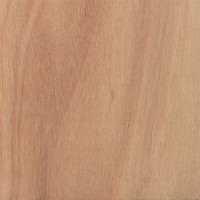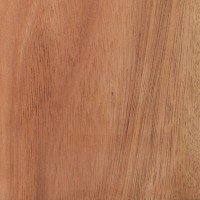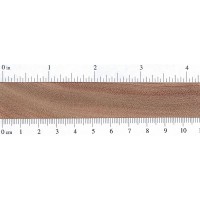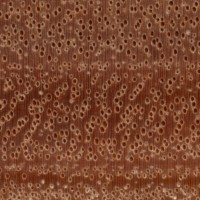 |
Common Name(s): Lyptus® Scientific Name: Eucalyptus urograndis (Eucalyptus grandis x E. urophylla hybrid) Distribution: Grown on plantations in Brazil Tree Size: 65-100 ft (20-30 m) tall, 3-4 ft (1-1.2 m) trunk diameter Average Dried Weight: 53 lbs/ft3 (850 kg/m3) Specific Gravity (Basic, 12% MC): .60, .85 Janka Hardness: 1,420 lbf (6,330 N) Modulus of Rupture: 17,110 lbf/in2 (118.0 MPa) Elastic Modulus: 2,049,000 lbf/in2 (14.13 GPa) Crushing Strength: 8,640 lbf/in2 (59.6 MPa) Shrinkage: Radial: 8.2%, Tangential: 12.8%, Volumetric: 21.0%, T/R Ratio: 1.6 |
Color/Appearance: Color ranges from a lighter salmon pink to a darker brownish red. Appearance has been likened to both Black Cherry and Honduran Mahogany. Color tends to deepen with age.
Grain/Texture: Has a medium texture and small to medium sized open pores. The grain tends to be straight and even. Also, since the wood is grown and pruned on a plantation, there tends to be few knots or other abnormal grain patterns.
Endgrain: Diffuse-porous; large to very large pores arranged in diagonal rows, few; exclusively solitary; tyloses occasionally present; growth rings indistinct; narrow rays usually not visible without lens, fairly close spacing; parenchyma vasicentric.
Rot Resistance: Mixed reports, with most sources rating the heartwood as moderately durable in regard to decay resistance, though it is susceptible to insect attack.
Workability: Generally easy to work, though it can burn easily. Glues, stains, and finishes well.
Odor: No characteristic odor.
Allergies/Toxicity: Besides the standard health risks associated with any type of wood dust, no further health reactions have been associated with Lyptus®. See the articles Wood Allergies and Toxicity and Wood Dust Safety for more information.
Pricing/Availability: Should be reasonably priced, especially for an import. (This is most likely due to the source of the wood: which is exclusively grown on plantations.)
Sustainability: This wood species is not listed in the CITES Appendices or on the IUCN Red List of Threatened Species.
Common Uses: Flooring, lumber, interior millwork, cabinetry, plywood, and turned objects.
Comments: Lyptus® is merely a trade name, which is a registered trademark owned by the Brazilian company Fibria. The Lyptus® brand is marketed in the United States by Weyerhaeuser. The actual tree species, which is grown on Brazilian plantations owned by Fibria, is a Eucalyptus hybrid of Eucalyptus grandis and E. urophylla.
In terms of mechanical/physical characteristics, Lyptus® has a very high shrinkage rate, and is likely to experience a fair amount of seasonal movement. The wood is relatively hard, heavy, and strong, though as a general rule, the paler pinkish brown boards tend to be less dense, while the darker reddish brown boards tend to be heavier and harder.
- Blue Gum (Eucalyptus globulus)
- Brown Mallee (Eucalyptus dumosa)
- Coolibah (Eucalyptus coolabah)
- Deglupta (Eucalyptus deglupta)
- Jarrah (Eucalyptus marginata)
- Karri (Eucalyptus diversicolor)
- Messmate (Eucalyptus obliqua)
- Mountain Ash (Eucalyptus regnans)
- Red Mallee (Eucalyptus oleosa)
- River Red Gum (Eucalyptus camaldulensis)
- Rose Gum (Eucalyptus grandis)
- Swamp Mahogany (Eucalyptus robusta)
- White Box (Eucalyptus hemiphloia)
- Yellow Box (Eucalyptus melliodora)
- Yellow Gum (Eucalyptus leucoxylon)








sanding to 2000 and 46 mega pixels camera.
Hello Erik, i got like gift one more piece off pink heavy wood. I try identify and look like lyptus ? Thx alot.
To be honest, a lot of the Eucalyptus species look similar. It would be very hard to ID down to species level in a lot of cases. Do you happen to know the weight of this piece?
Hello Erik, size is 75mm x 75mm x 295mm weight is 1586g
Those numbers put in the range of about 980 kg/m3 at 12% MC. There are a lot of heavier Eucalyptus species that could be possibilities. Unfortunately, I don’t have all the eucalyptus images uploaded and up on the site yet.
Thx alot Erik for help and your time, if you are sure and this endgrain look like eucaliptus that is all what i need to know. I understeand how many species off eucalitpus exist. This wood just surprice mine how heavy and hard to sand it is. Propably i say hand sanding is harder them sand lilac. For mine non profitable hobby knife making is nice to know wich wood i use for a handle. And this wood figure looks good.
Would this wood work well for a picnic bench?
From my experience, I would say yes. It does have some rot and insect resistance, but, like any outdoor project, it will require yearly maintenance to keep the elements at bay. I have not experienced the movement issues that others have, but all of my Lyptus projects have been indoor furnishings so that stands to reason. Best advice I can give you is to pick boards that are darker in color since they will tend to be harder and more dense. This, along with appropriate joinery methods for the application, will help make your outdoor project last longer. Good luck!
We had Lyptus raised panel cabinetry in a house we built in 2002. I never noticed any shrinkage or seasonal movement while living there for 15 years. It is beautiful wood.
Great wood all of my cabinets are made of Lyptus since 2007. Still looks new. Very Happy with it
I wanted to comment on the durability of Lyptus. I’ve had a 1/4″ piece of plywood and 5/4×12″ boards leftover from a project that was sitting out in a unconditioned shed for at least the last 10 years. After scraping off the bugs and dirt I used in it a project last week. Besides having to take the warp out of the plywood (it was leaning against a wall for a decade) it appears to have just come off the truck. I wish I would have taken before and after shots. The stuff is bug resistant and holds up better… Read more »
I have been using Lyptus to build fine furniture in commercial and residential applications since 2008. I have had nothing but great success. My challenge is getting inventory. Suppliers here in West Canada do not supply it. I’m forced to order a entire lift at a time. To my knowledge virtually no one is using it in my region. I’m pleased to be a advicate for spreading the word on this great hybrid wood, Lyptus. A suggestion is to try making a endgrain cutting board. The endgrain patern is fantastic.
“Related to red gum” don’t trust it on a large project. Build something small with joints and place in a dry heated space for a year or so. You won’t like it.
Made a 6 foot by 4 food oval ended table out of edge joined lyptus and it sat in an unairconditioned garage for 5 years while we were cruising the atlantic in our sailboat. 15 years later it is still straiter than a strait board so to speak. Great fot big projects just use true and tried building methods so it can naturally expand and contract with the seasons.
What about making a frame with tenon and mortise, and glued and clamped
Will it Rot outside I’d like to make a door for a storm window for outside use, I can stain and seal it. It would probably look better anyway. A nice deep reddish brown would look nice.
I wouldn’t trust it outdoors unprotected. However, I’ve heard that rot resistance varies depending on the growing conditions of the tree, and generally the boards that are naturally a very dark red have better resistance than boards that are naturally a lighter pink color.
It is necessary to apply a sealer ???
Does anyone know the worth of such a tree
directly on the plantation ?
I want to grow Eukalyptus-Hybrid-Clones Grandis-Camadulensis
thanks
I just put in a 54″x72″ laminated Counter top of Lyptus. It turned out beautifully. Routed the ends which had no tear out or chips. Machined really easy. It is a hard wood and very heavy. I’ve had a very minimal amount of movement in the top. After clear staining to preserve the rich pinkish color, I finished it off with two coats of “Good Stuff” a non-toxic finisher which food can be placed on. Tons of small splinters when working it though. I’ve seen it used as a restaurant counter top with little if any problems.
Used it for interior trim. It works well and finishes beautifully.I wonder if it is stable enough to make up large table tops?
Yes.
good stuff, chiped the ends and nailed it to my ceiling, been there ever since.
I had some beautiful deep red 8/4 lyptus that I used for the base of my workbench. Machined well and finished gorgeously… but LOTS of splinters in my hands while I was working it. Wouldn’t hesitate to use it for some furniture if I got hold of some more!